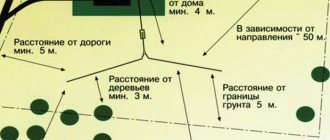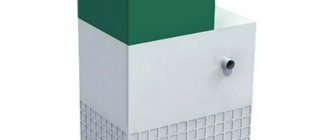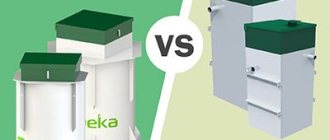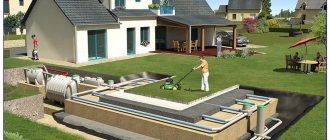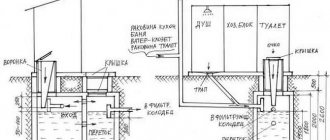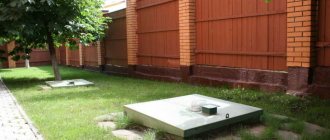Before we begin the analysis, let's understand the terminology. Autonomous sewerage
– a treatment plant or system of structures that is an alternative to the central sewerage system.
This definition includes both a biological treatment station and a septic tank with a post-treatment system. A separate septic tank
, whether plastic or made of concrete rings, is not a full-fledged autonomous sewer system, but can become part of it.
An autonomous sewage system is often called a biological treatment station, since all biological processes occur in one building and there is no need for additional equipment. In this article we will compare a septic tank with post-treatment
and a biological treatment station (BTP), and we will also tell you about other ways to organize sewerage on your site. For convenience, we will call the SBO an autonomous sewer system.
A septic tank is cheap, without electricity and reliable!
This opinion is firmly entrenched in the minds of our clients. And this statement is partly true, but not everything is so simple.
Septic tank is cheap
Indeed, if you look first at the cost of a septic tank, and then at the price of an autonomous sewer system, you can see the difference is not in favor of the station. However, do not forget that a septic tank is not a full-fledged treatment device; after it, additional treatment must be organized on the site. And not only sales managers of sewerage products tell us about this, but also SNiP 2.04.03-85 (clause 6.78):
6.78. Septic tanks should be used for mechanical treatment of wastewater entering underground filtration fields, sand and gravel filters, filter trenches and filter wells.
Even the most inexpensive method of post-treatment - an infiltration well - costs 12,500 rubles, excluding the cost of crushed stone. Crushed stone will cost an additional 4,500 rubles per cubic meter. Add all this to the cost of the sump. If you consider the installation of a turnkey septic tank with filtration fields or a biofilter, it turns out even more expensive.
A septic tank does not require electricity
If you have filter soil (sand) and a low groundwater level on your site, then yes. When the site is located on clay soil or on soil with a high groundwater level, then only a biofilter with an electric pump for removing purified water is suitable as a post-treatment for a septic tank. In this case, the energy independence of the system is lost.
For a dacha, a septic tank is more suitable than an autonomous sewer system
Whether you have a dacha or a country house, it doesn’t matter when choosing the type of sewer system. The type of soil is important. If the soil is non-filtering or weakly filtering (loam), then the post-treatment will not work and at the slightest discharge the sedimentation tank will flood.
Septic tank is reliable
All overflows in the septic tank are gravity-fed and at first glance it seems that there is nothing to break. This is true in the following cases:
- Septic tank without defects.
- Installed according to all rules.
Otherwise this happens.
Fig.1. The clay squeezed the septic tank and deformed it
Septic tank - install it and forget it
The passports of factory septic tanks indicate that the sump tank needs to be serviced once every 1-2 years, but there are also stories on the Internet about maintenance once every 5 years. Is this possible? If you come to your dacha and use the sewer system only on summer and spring weekends (and not every weekend), then yes, it’s possible. But if you live in your country house permanently or even seasonally for six months, then you will have to service the septic tank more often.
And if the septic tank is not maintained, the quality of cleaning will deteriorate, and as a result, the filter elements will silt up, which will then have to be dug up.
Bottom line: A septic tank is not for everyone
A septic tank can really be an inexpensive and very convenient solution for organizing sewerage on a site. And yet it is not suitable for everyone. Therefore, the statement that a septic tank is the only true, cheapest and most reliable treatment facility is untrue and a myth.
Of course, this does not prevent some people who want to save money at all costs from ignoring warnings and hoping for a miracle, but you saw the consequences of this in Figure 1.
Installation
Installation of a septic tank is, in fact, the only thing you have to pay for. The installation will be carried out by Eco-Bio specialists. This is the only condition under which the warranty will be valid. After all, only when carrying out independent installation can we be sure that it was done correctly and the septic tank was not damaged during the work.
Installation of a septic tank occurs quite quickly - you just need to correctly calculate the volume and build the correct connection diagram.
There may be plenty of connection diagram options. Water from a toilet, bathhouse, kitchen, bathroom, or garage can be drained into one septic tank. An autonomous sewage system can handle almost all chemical compounds (except gasoline and similar substances). The question is whether you will use the water after passing through the septic tank. If yes, then you need either a bioseptic tank or an additional purification stage in the form of filtration fields. And these are completely different connection schemes.
Connecting to the city sewerage system is a long, boring and complicated process. It is necessary to coordinate the project, approve it, and check everything for compliance with the requirements. At any stage you can be turned back. Not too encouraging, right?
And the septic tank meets all sanitary and hygienic requirements in advance; it only needs to be positioned correctly. Well, you and I won’t have any problems with this.
The station is expensive, unreliable, and heavily dependent on electricity
Now let's take a closer look at this stereotype.
The station is expensive
It’s difficult to call a biological treatment station a cheap installation, but in some cases, installing an autonomous sewage system on a site is cheaper than a septic tank with post-treatment. For example, if there is clay on the site. In case of difficult soil conditions, a septic tank requires:
- Sprinkling with cement-sand mixture.
- Anchoring.
- Factory biofilter as a post-treatment.
All this will require additional investments and increases the cost of sewerage significantly.
The station is unreliable
Overflows in most stations are carried out using airlifts (mamut pumps), and there is an opinion that they often become clogged. And the compressors supposedly break down quickly, thanks to which the airlifts operate and the drain is saturated with oxygen. This statement is greatly exaggerated. With regular and proper maintenance of your autonomous sewer system, as well as proper operation of the system, nothing will become clogged or broken.
The station is volatile, and after a short power outage the quality of cleaning suffers
The first statement is true, the second is not. Autonomous sewerage can easily withstand a power outage for 6-8 hours, and the quality of the drainage does not suffer after power supply. Therefore, you can safely install the station in areas where the light periodically goes out.
The station requires frequent maintenance
“By buying a station, you turn into its slave,” this phrase periodically appears on forums dedicated to country life. People are scared by the need for frequent maintenance, saying that the station needs to be washed, cleaned and removed from blockages almost every two months. Of course, this is complete nonsense. If you live permanently in a country house, it is enough to carry out maintenance once every 6 months. For seasonal use – once a year. If you come to your dacha only on weekends in the summer, then once every 1.5 years.
Bottom line: The station is convenient and accessible
Biological treatment stations have become widespread in Russia relatively recently, so there are still a lot of rumors and myths around them. And yet, a more convenient solution for autonomous sewerage in a country house does not currently exist. Especially when the site has difficult soil conditions - and in the Leningrad, Moscow and Sverdlovsk regions such conditions occur in 95% of cases.
Now that we have dispelled the main myths about septic tanks and autonomous sewage systems, we will consider each method of cleaning drainage in a dacha in more detail.
Application of a septic tank
A septic tank can treat wastewater from a country house, country house or cottage. The volume of the sedimentation tank should be equal to three times the daily flow rate. That is, if two people drain 200 liters of water per day each, then they should purchase a septic tank for 1200 liters (2 people * 200 l * 3 = 1200 l).
A settling tank is usually installed in filtering dry soil. Such soils include sand, sandy loam, and limestone. The groundwater level on the site should be no higher than 2.5 meters. To install a sedimentation tank in clay or in soil with a high groundwater level, it is necessary to purchase an expensive after-treatment system.
Fig.2. The post-treatment system for a septic tank can consist of six biofilter blocks, in this case the total cost of sewerage without taking into account installation reaches 200 thousand rubles.
Suitable for both seasonal cottages and cottages intended for permanent residence.
Conclusion
If a large amount of water is regularly consumed in a house, it will be economically feasible to install an autonomous sewage system. In spacious areas where the soil has a high level of permeability and water is used irregularly or seasonally, it is more effective to install a septic tank.
Using the product catalog, you can purchase septic tanks for a private home or summer cottage. We also sell models with a biofilter. Our managers will advise you and help you make your choice.
share:
The principle of operation of a septic tank
There are settling tanks:
- Plastic.
- Made from concrete rings.
Both options are popular, but the concrete sump is gradually becoming obsolete, people prefer plastic ones.
They are a cylindrical or rectangular container, divided inside into three chambers. In the first, largest, compartment, water is separated from large debris, suspended matter and fat. In the second and third, the wastewater is purified from smaller particles. Water flows from chamber to chamber by gravity without pumps, making the septic tank a non-volatile device.
According to SNiP, after the septic tank, it is necessary to provide for additional wastewater treatment, since cloudy, bad-smelling water comes out of the sump. For post-treatment, a filter well, underground filtration fields or a factory biofilter are used.
Advantages and disadvantages of a septic tank
| Advantages | Flaws |
| Low price of device and installation. True, this only applies to the sump system plus a filter well/filtration field. However, when installing a septic tank of 3 cubic meters (conventionally, this is 5 users), the difference in price is leveled out. | Can only be installed in dry filter soil. Otherwise, you need to buy a biofilter. This is expensive and the system's energy independence is lost. |
| Non-volatile system. | A sewer truck is required for maintenance. |
| Does not require frequent maintenance - only once every 1-2 years. | According to the passport, a complete replacement of post-treatment is required every 10-15 years. In practice - much more often. |
| Does not require preservation for the winter. | |
| Non-degradable items can be dumped into the septic tank; they do not clog the device and are then easily removed with a sewer. |
Application of an autonomous sewage system
Installed on site for organizing wastewater treatment of private houses, cottages or mini-hotels. Just like sedimentation tanks, they can operate both year-round and only in the spring-summer period. Although periodic use has its own nuances.
The soil and groundwater level do not matter for autonomous sewerage. What is important is the volume of incoming wastewater, the depth of the drain pipe and the method of discharging clean water.
Fig.5. Forced station with clean water discharge into a ditch. If there is no storm drain on the site, water can be discharged into a reservoir, onto a slope, or accumulated in barrels for irrigation
What is better to choose and under what conditions will the choice be justified?
Having figured out how a septic tank differs from an autonomous sewer system, you can begin choosing a device for your site. But it's not that simple. It is important to understand for what purposes the structure will be used. It also all depends on the conditions that the local area meets.
An autonomous sewer system is equipped with a post-treatment station, if it is necessary to discharge residues into a reservoir Source quartz-stroy.rf
So, when choosing a septic tank and autonomous sewage system, you need to pay attention to:
- the type of soil in the area where it is planned to install the system;
- number of people in the house (if the family is large, then autonomous sewerage is definitely a priority);
- the number of wastewater transferred to the treatment system;
- temperature conditions;
- consistency of operation (if the structure is being built for a residential building, then it is better to give preference to an autonomous sewage system, since it will be larger and faster to process biological waste).
Note! A septic tank is often a temporary structure if it is not part of an autonomous sewer system. Ideal for collecting small amounts of waste and infrequently refilling containers.
Operating principles of autonomous sewerage
The wastewater treatment at the station occurs thanks to aerobic and anaerobic bacteria. As a result of their vital activity, complex organic compounds break down into simpler ones, the runoff gets rid of harmful substances, is purified and discharged to the ground. Unlike septic tanks, autonomous sewage systems purify water by 98%, which allows it to be immediately discharged into a ditch without additional treatment.
An aeration septic tank can have from three to six chambers. They mix the drainage, clean it and cut off sludge from clean water with its subsequent discharge to the outside. The most important difference between the operating principle of an autonomous sewer system and the operating principle of a septic tank is the participation of aerobic bacteria in wastewater treatment. Oxygen is necessary for their life activity, and in order to saturate the runoff with it, special elements are provided in the station - aerators.
The drain flows from chamber to chamber via airlifts or by gravity.
Autonomous sewer electrics
Pumping of waste from chamber to chamber in stations occurs using compressed air, which is supplied to all elements by one or two compressors. Accordingly, such an installation will not work without electricity.
In stations with forced drainage, a drainage pump is also provided. And to protect all electrics, an alarm is required (only if the compressor is located inside the station).
Important! Most manufacturers do not provide hazard warning lights included. However, he gives it to his clients.
Connection to the central network
After connecting the internal sewerage network to the manhole, an application for connection is submitted to Vodokanal. The insertion is carried out in the presence of a representative of Vodokanal. He participates in the inspection of the branch, its compliance with design data, in checking the system (by pouring) and the tie-in for leaks. If defects are detected, they are included in a special list. If existing defects prevent the system from being accepted, the owner of the connected house is given time to correct it. If no such defects are found, based on the results of the work performed, a long-awaited document is drawn up - an acceptance certificate, which is signed by a representative of Vodokanal.
The connection to the centralized sewer network is carried out by Vodokanal specialists. It can be carried out in two ways: through a tee, using an adapter.
- The sewer pipe is cut, a piece is cut out of it along the length of the tee being installed. The edges of the cuts are cleaned. A coupling is put on one end of the pipe, and a tee on the other (it and the coupling must have a liner and be lubricated with silicone). The coupling connects the tee to the second part of the pipe.
- The adapter is a special fitting. It costs more, however, this design is more durable. The adapter has a nozzle corresponding to the diameter of the supply pipe. The section of the sewer pipe is cleaned and a hole is cut out in it. The edges of the hole are cleaned. Cover all joining surfaces with sealant, put the adapter on the pipe leading from the inspection well and place it on the Vodokanal pipe. The cover is attached to the pipe using clamps.
The final document authorizing the connection of a private house to the central sewer system is the act of acceptance of connection and pressure testing of the line, signed after testing by a representative of Vodokanal. After signing the act, a drainage agreement is drawn up and signed.
Advantages and disadvantages of autonomous sewerage
| Advantages | Flaws |
| High degree of wastewater treatment. | Preservation for the winter is necessary in case of seasonal use. |
| Self-service is possible without calling a vacuum cleaner (in most stations). | The compressor needs to be replaced every 5 years. |
| A wide range of stations - from low-productivity to devices for 150-200 people. | Requires maintenance every 6 months for constant use and every 12 months for seasonal use. |
| Possibility to use the station both permanently and seasonally. | Relatively high price. |
| Takes up little space on the site. | They consume electricity on average 1.5 kW/day. In rubles – 5 rubles/day or 150 rubles/month. |
| Suitable for any soil. | |
| Does not require anchoring. |
Service
Central sewerage is a constant expense of money. Moreover, first of all, this is not a subscription fee (which, by the way, is also quite considerable), but a kind of “microtransaction”, i.e. constant small payments for various services. And you have to pay for everything. For example, for fixing problems that happen very often.
What does a septic tank offer us? It requires almost no maintenance (only annual sludge removal is on the list of necessary operations) and, subject to operating conditions, does not break down or begin to work less efficiently. A septic tank does not need the services of a septic tank - this is already a thing of the past.
Moreover, septic tank service costs very little, and during the warranty period it is completely free.

